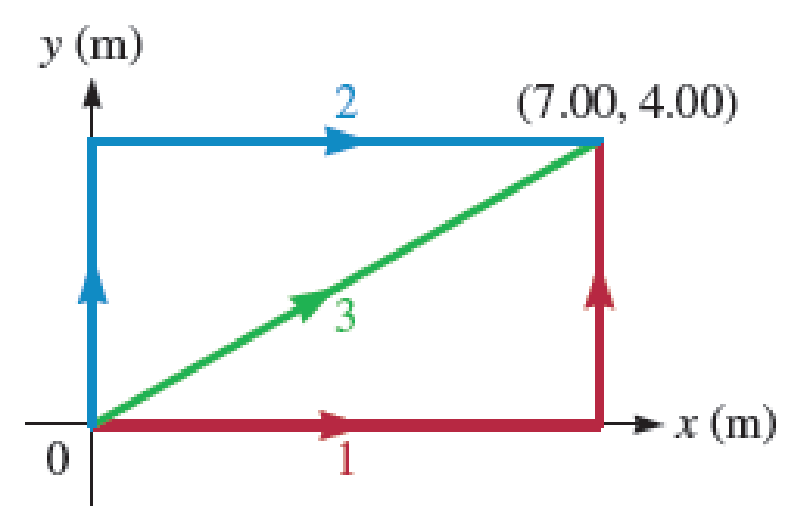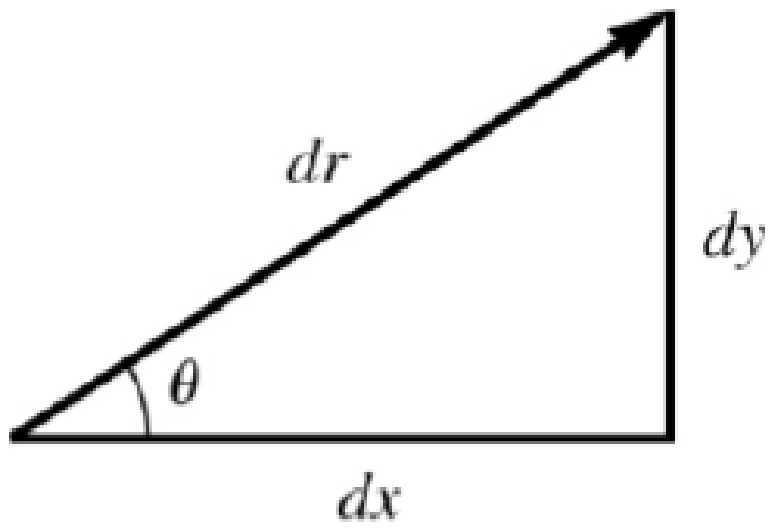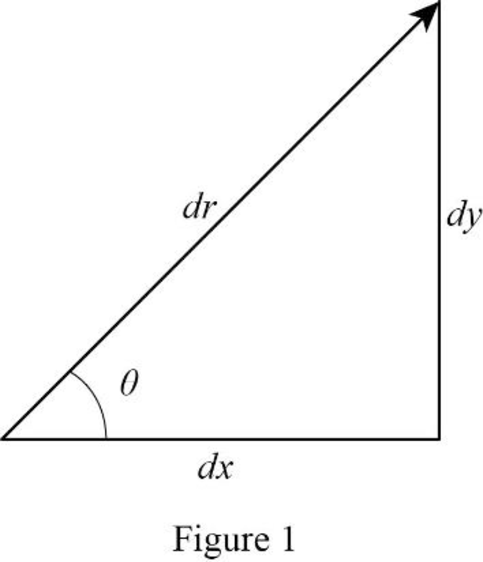
Concept explainers
A particle moves in the xy plane (Fig. P9.30) from the origin to a point having coordinates x = 7.00 m and y = 4.00 m under the influence of a force given by
- a. What is the work done on the particle by the force F if it moves along path 1 (shown in red)?
- b. What is the work done on the particle by the force F if it moves along path 2 (shown in blue)?
- c. What is the work done on the particle by the force F if it moves along path 3 (shown in green)?
- d. Is the force F conservative or nonconservative? Explain.

FIGURE P9.30
In each case, the work is found using the integral of
(a) The work done along path 1, we first need to integrate along
Performing the dot products, we get
Along the first part of this path, y = 0 therefore the first integral equals zero. For the second integral, x is constant and can be pulled out of the integral, and we can evaluate dy.
(b) The work done along path 2 is along
Performing the dot product, we get:
Along the first part of this path, x = 0. Therefore, the first integral equals zero. For the second integral, y is constant and can be pulled out of the integral, and we can evaluate dx.
(c) To find the work along the third path, we first write the expression for the work integral.
At first glance, this appears quite simple, but we can’t integrate
Now, use equation (2) in (1) to express each integral in terms of only one variable.
We can determine the tangent of the angle, which is constant (the angle is the angle of the line with respect to the horizontal).
Insert the value of the tangent and solve the integrals.
(d) Since the work done is not “path-independent”, this is

Figure P9.30ANS
(a)
The work done on the particle by the force
Answer to Problem 30PQ
The work done on the particle by the force
Explanation of Solution
The path 1 followed by the particle is given in Figure P9.30. Given that the coordinate of the final position of the particle is
Write the expression for the work done by a force.
Here,
The path 1 of the particle consist of two parts. Motion from
Use the force vector along with the limits of integration and perform the integration (represent the work done along path 1 as
Perform the dot product to reduce the integral (II).
Along the first part of the path 1,
Conclusion:
Therefore, the work done on the particle by the force
(b)
The work done on the particle by the force
Answer to Problem 30PQ
The work done on the particle by the force
Explanation of Solution
The path 2 followed by the particle is given in Figure P9.30. Given that the coordinate of the final position of the particle is
Equation (I) gives the expression for the work done by a force.
The path 2 of the particle consist of two parts. Motion from
Use the force vector along with the limits of integration and perform the integration (represent the work done along path 2 as
Perform the dot product to reduce the integral (IV).
Along the first part of the path 2,
Conclusion:
Therefore, the work done on the particle by the force
(c)
The work done on the particle by the force
Answer to Problem 30PQ
The work done on the particle by the force
Explanation of Solution
The path 3 followed by the particle is given in Figure P9.30. Given that the coordinate of the final position of the particle is
Equation (I) gives the expression for the work done by a force.
Write equation (I) in terms of
Use the
The path 3 of the particle starts from
Here, both

Write the expression relating
Solve equation (IX) for
Solve equation (IX) for
Use equation (X) and (XI) in (VIII).
Compute
Use equation (XIII) in (XII) and perform the integral.
Conclusion:
Therefore, the work done on the particle by the force
(d)
Whether the force
Answer to Problem 30PQ
The force
Explanation of Solution
From part (a), (b) and (c) it is found that the work done by the force
Conclusion:
Therefore, the force
Want to see more full solutions like this?
Chapter 9 Solutions
EBK WEBASSIGN FOR KATZ'S PHYSICS FOR SC
- 1. What is the spring constant of a spring that starts 10.0 cm long and extends to 11.4 cm with a 300 g mass hanging from it?arrow_forwardplease help me solve all parts of this question from physics. thanks so much in advance! :)))arrow_forwardA fluid with density 263 kg/m3 flows through a pipe of varying diameter and height. At location 1 the flow speed is 13.5 m/s and the diameter of the pipe is 7.4 cm down to location 2 the pipe diameter is 16.9 cm. Location 1 is 6.3 meters higher than location 2. What is the difference in pressure P2 - P1? Using units in Pascals and use g = 9.81 m/s2.arrow_forward
- The kitchen had a temperature 46 degrees Fahrenheit and was converted it to Kelvin. What is the correct number for this temperature (46 F) on the Kelvin scale?arrow_forwardWater is traveling at a speed of 0.65 m/s through a pipe with a cross-section radius of 0.23 meters. The water enters a section of pipe that has a smaller radius, only 0.11 meters. What is the speed of the water traveling in this narrower section of pipe?arrow_forwardA particular water pipe has a radius of 0.28 meters. If the pipe is completely filled with water, moving with average velocity 0.45 m/s, what is the flow rate of water through the pipe with units of cubic meters of water per second?arrow_forward
- Water is flowing through a horizontal pipe with two segments. In one segment, the water flows at a speed v1 = 4.52 m/s. In the second segment the speed of the water is v2 = 2.38 m/s. Based on Bernoulli's Principle, what is the difference in pressure (P2 - P1) between the two segments? Assume that the density of the water is 997 kg/m3 and give your answer as the number of Pascals (i.e. N/m2).arrow_forwardWater from the faucet is supplied to the hose at a rate of 0.00057 m3/s. At what speed (number of meters per second) does the water exit the nozzle if the cross sectional area of the narrow nozzle is 2.1 x 10-6 m2?arrow_forwardJason Fruits/Indiana University Research Communications Silver/ silver oxide Zinc zinc/oxidearrow_forward
- Car P moves to the west with constant speed v0 along a straight road. Car Q starts from rest at instant 1, and moves to the west with increasing speed. At instant 5, car Q has speed w0 relative to the road (w0 < v0). Instants 1-5 are separated by equal time intervals. At instant 3, cars P and Q are adjacent to one another (i.e., they have the same position). In the reference frame o f the road, at instant 3 i s the speed o f car Q greater than, less than, or equal to the speed of car P? Explain.arrow_forwardCar P moves to the west with constant speed v0 along a straight road. Car Q starts from rest at instant 1, and moves to the west with increasing speed. At instant 5, car Q has speed w0 relative to the road (w0 < v0). Instants 1-5 are separated by equal time intervals.arrow_forwardCar P moves to the west with constant speed v0 along a straight road. Car Q starts from rest at instant 1, and moves to the west with increasing speed. At instant 5, car Q has speed w0 relative to the road (w0 < v0). Instants 1-5 are separated by equal time intervals. Sketch and label a vector diagram illustrating the Galilean transformation of velocities that relates velocity of car P relative to the road, velocity of car Q relative to road, and velocity of car Q relative to car P at instant 3. In the frame of car P, at instant 3 is car Q moving to the west, moving to the east, or at rest? Explain.arrow_forward
 Physics for Scientists and Engineers: Foundations...PhysicsISBN:9781133939146Author:Katz, Debora M.Publisher:Cengage Learning
Physics for Scientists and Engineers: Foundations...PhysicsISBN:9781133939146Author:Katz, Debora M.Publisher:Cengage Learning Principles of Physics: A Calculus-Based TextPhysicsISBN:9781133104261Author:Raymond A. Serway, John W. JewettPublisher:Cengage Learning
Principles of Physics: A Calculus-Based TextPhysicsISBN:9781133104261Author:Raymond A. Serway, John W. JewettPublisher:Cengage Learning Physics for Scientists and Engineers with Modern ...PhysicsISBN:9781337553292Author:Raymond A. Serway, John W. JewettPublisher:Cengage Learning
Physics for Scientists and Engineers with Modern ...PhysicsISBN:9781337553292Author:Raymond A. Serway, John W. JewettPublisher:Cengage Learning Physics for Scientists and Engineers, Technology ...PhysicsISBN:9781305116399Author:Raymond A. Serway, John W. JewettPublisher:Cengage Learning
Physics for Scientists and Engineers, Technology ...PhysicsISBN:9781305116399Author:Raymond A. Serway, John W. JewettPublisher:Cengage Learning Physics for Scientists and EngineersPhysicsISBN:9781337553278Author:Raymond A. Serway, John W. JewettPublisher:Cengage Learning
Physics for Scientists and EngineersPhysicsISBN:9781337553278Author:Raymond A. Serway, John W. JewettPublisher:Cengage Learning College PhysicsPhysicsISBN:9781938168000Author:Paul Peter Urone, Roger HinrichsPublisher:OpenStax College
College PhysicsPhysicsISBN:9781938168000Author:Paul Peter Urone, Roger HinrichsPublisher:OpenStax College





